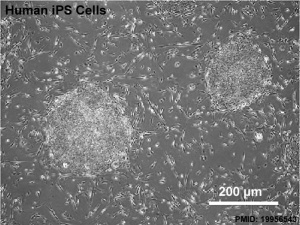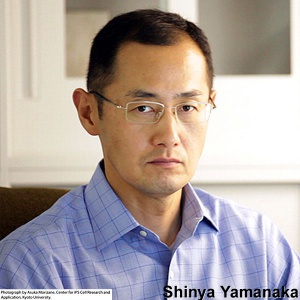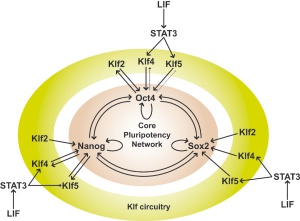Embryology History - Shinya Yamanaka
Introduction
Professor Yamanaka has had a key role to play in identifying the specific 4 factors required alone to transform a cell from adult tissues into stem cells. These 4 factors have also been called "Yamanaka Factors" and the stem cells formed, by their introduction or expression, are called "induced Pluriopotential Stem Cells" (iPS). This finding[1] has been the basis of many recent stem cell papers. These "Yamanaka Factors" are transcription factors, that also have other developmental roles, and can regulate the expression of a range of other nuclear genes.
Yamanaka Factors:
- Oct3/4 - Octamer-binding transcription factor 3/4
- Sox2 - Sry-related HMG-box gene 2
- Klf4 - Kruppel-like factor 4
- c-Myc - MYC protooncogene
- Links: Induced Stem Cells | stem cells | John Gurdon | SOX
Some Recent Findings
|
The Nobel Prize in Physiology or Medicine 2012 was awarded jointly to Sir John B. Gurdon and Shinya Yamanaka
|
Recent References | References
Research History

- 1987 - M.D. at Kobe University, worked as a resident in orthopedic surgery at National Osaka Hospital for two years.
- 1993 - Ph.D. in medicine at Osaka City University and moved to the United States as a postdoctoral fellow at the Gladstone Institute of Cardiovascular Disease, in San Francisco, CA.
- 1996 - Assistant professor at Osaka City University School of Medicine.
- 1999 - Associate professor at the Nara Institute of Science and Technology.
- 2004 - Professor at Kyoto University.
- 2010 - Director of Center for iPS Cell Research and Application at Kyoto University. Kyoto Prize in Advanced Technology | Lecture text PDF
- 2012 - The Nobel Prize in Physiology or Medicine 2012 awarded jointly with Sir John B. Gurdon "for the discovery that mature cells can be reprogrammed to become pluripotent".
2016 Interview
<html5media width="480" height="360">https://www.youtube.com/embed/--o1aux_htA</html5media>
Development - 2016 Interview with Shinya Yamanaka (inducible Stem Cells)
| YouTube Links |
|---|
| Note - this may include both internal and external movie links.
|
Key Paper
Induction of pluripotent stem cells from mouse embryonic and adult fibroblast cultures by defined factors
Cell. 2006 Aug 25;126(4):663-76. Epub 2006 Aug 10.[1]
Takahashi K, Yamanaka S.
Department of Stem Cell Biology, Institute for Frontier Medical Sciences, Kyoto University, Kyoto 606-8507, Japan.
Abstract
Differentiated cells can be reprogrammed to an embryonic-like state by transfer of nuclear contents into oocytes or by fusion with embryonic stem (ES) cells. Little is known about factors that induce this reprogramming. Here, we demonstrate induction of pluripotent stem cells from mouse embryonic or adult fibroblasts by introducing four factors, Oct3/4, Sox2, c-Myc, and Klf4, under ES cell culture conditions. Unexpectedly, Nanog was dispensable. These cells, which we designated iPS (induced pluripotent stem) cells, exhibit the morphology and growth properties of ES cells and express ES cell marker genes. Subcutaneous transplantation of iPS cells into nude mice resulted in tumors containing a variety of tissues from all three germ layers. Following injection into blastocysts, iPS cells contributed to mouse embryonic development. These data demonstrate that pluripotent stem cells can be directly generated from fibroblast cultures by the addition of only a few defined factors.
Comment in:
Yamanaka Factors

Yamanaka Factors[8][9] Are a set of 4 transcription factors when introduced into cells induces stem cell formation. These four transcription factors can be expressed from doxycycline (dox)-inducible lentiviral vectors.
OCT4
- Transcription factors containing the POU homeodomain
- Links: OMIM - OCT4
SOX2
- Sry-related HMG-Box gene 2
- Sox2 is first expressed in very early (morula, blastocyst) development.
- Forms a trimeric transcription complex with OCT4.
- Gene targets - YES1, FGF4, UTF1 and ZFP206.
- Links: SOX | OMIM - SOX2
KLF4
- Kruppel-like factor 4, zinc finger protein, transcription factor which acts as both an activator and repressor.
- Links: OMIM - KLF4
cMyc
- The MYC protooncogene encodes a DNA-binding factor that can activate and repress transcription.
- Ectopic expression of c-Myc can also cause tumorigenicity in offspring.
- Links: OMIM - MYC
- More recently shown that Oct4 together with either Klf4 or c-Myc is sufficient to generate iPS cells from neural stem cells.[10]
- Tbx3 transcription factor significantly improves the quality of iPS cells.[11]
Historic Embryologists
| Embryologists: William Hunter | Wilhelm Roux | Caspar Wolff | Wilhelm His | Oscar Hertwig | Julius Kollmann | Hans Spemann | Francis Balfour | Charles Minot | Ambrosius Hubrecht | Charles Bardeen | Franz Keibel | Franklin Mall | Florence Sabin | George Streeter | George Corner | James Hill | Jan Florian | Thomas Bryce | Thomas Morgan | Ernest Frazer | Francisco Orts-Llorca | José Doménech Mateu | Frederic Lewis | Arthur Meyer | Robert Meyer | Erich Blechschmidt | Klaus Hinrichsen | Hideo Nishimura | Arthur Hertig | John Rock | Viktor Hamburger | Mary Lyon | Nicole Le Douarin | Robert Winston | Fabiola Müller | Ronan O'Rahilly | Robert Edwards | John Gurdon | Shinya Yamanaka | Embryology History | Category:People | ||
|
References
- ↑ 1.0 1.1 Takahashi K & Yamanaka S. (2006). Induction of pluripotent stem cells from mouse embryonic and adult fibroblast cultures by defined factors. Cell , 126, 663-76. PMID: 16904174 DOI. Cite error: Invalid
<ref>tag; name 'PMID16904174' defined multiple times with different content - ↑ Fujishiro SH, Nakano K, Mizukami Y, Azami T, Arai Y, Matsunari H, Ishino R, Nishimura T, Watanabe M, Abe T, Furukawa Y, Umeyama K, Yamanaka S, Ema M, Nagashima H & Hanazono Y. (2013). Generation of naive-like porcine-induced pluripotent stem cells capable of contributing to embryonic and fetal development. Stem Cells Dev. , 22, 473-82. PMID: 22889279 DOI.
- ↑ Kajiwara M, Aoi T, Okita K, Takahashi R, Inoue H, Takayama N, Endo H, Eto K, Toguchida J, Uemoto S & Yamanaka S. (2012). Donor-dependent variations in hepatic differentiation from human-induced pluripotent stem cells. Proc. Natl. Acad. Sci. U.S.A. , 109, 12538-43. PMID: 22802639 DOI.
- ↑ <pubmed>19956543</pubmed>| PMC2780725 | PLoS One
- ↑ <pubmed>16923385</pubmed>
- ↑ <pubmed>20861870</pubmed>
- ↑ <pubmed>21103067</pubmed>| PMC2980489 | PLoS One.
- ↑ <pubmed>16904174</pubmed>
- ↑ <pubmed>18035408</pubmed>
- ↑ Kim JB, Zaehres H, Wu G, Gentile L, Ko K, Sebastiano V, Araúzo-Bravo MJ, Ruau D, Han DW, Zenke M & Schöler HR. (2008). Pluripotent stem cells induced from adult neural stem cells by reprogramming with two factors. Nature , 454, 646-50. PMID: 18594515 DOI.
- ↑ Han J, Yuan P, Yang H, Zhang J, Soh BS, Li P, Lim SL, Cao S, Tay J, Orlov YL, Lufkin T, Ng HH, Tam WL & Lim B. (2010). Tbx3 improves the germ-line competency of induced pluripotent stem cells. Nature , 463, 1096-100. PMID: 20139965 DOI.
Reviews
Articles
Yamanaka S & Blau HM. (2010). Nuclear reprogramming to a pluripotent state by three approaches. Nature , 465, 704-12. PMID: 20535199 DOI.
Takahashi K, Tanabe K, Ohnuki M, Narita M, Ichisaka T, Tomoda K & Yamanaka S. (2007). Induction of pluripotent stem cells from adult human fibroblasts by defined factors. Cell , 131, 861-72. PMID: 18035408 DOI.
Takahashi K & Yamanaka S. (2006). Induction of pluripotent stem cells from mouse embryonic and adult fibroblast cultures by defined factors. Cell , 126, 663-76. PMID: 16904174 DOI.
Journal of Visualized Experiments - Generating iPS Cells from MEFS through Forced Expression of Sox-2, Oct-4, c-Myc, and Klf4
Search PubMed
Search PubMed Now: Yamanaka+S | induced pluripotent stem cell |
Terms
- ESC - acronym for Embryonic Stem Cell. Stem cells that have been derived from an embryonic source, usually the blastocyst.
- hiPSC - acronym for human induced pluripotent stem cell. Stem cells originating from human somatic tissues that have been induced to differentiate into a stem cell by Yamanaka factors.
- iPS cell - (iPSC) acronym for induced Pluripotent Stem cell. Stem cells originating from somatic tissues of animals or humans that have been induced to differentiate into a stem cell by Yamanaka factors.
External Links
External Links Notice - The dynamic nature of the internet may mean that some of these listed links may no longer function. If the link no longer works search the web with the link text or name. Links to any external commercial sites are provided for information purposes only and should never be considered an endorsement. UNSW Embryology is provided as an educational resource with no clinical information or commercial affiliation.
- Center for iPS Cell Research and Application at Kyoto University.
- 2010 Kyoto Prize Laureate in Advanced Technology | Commemorative Lecture text PDF
- 2009 ScienceWatch interview
Glossary Links
- Glossary: A | B | C | D | E | F | G | H | I | J | K | L | M | N | O | P | Q | R | S | T | U | V | W | X | Y | Z | Numbers | Symbols | Term Link
Cite this page: Hill, M.A. (2024, April 27) Embryology Embryology History - Shinya Yamanaka. Retrieved from https://embryology.med.unsw.edu.au/embryology/index.php/Embryology_History_-_Shinya_Yamanaka
- © Dr Mark Hill 2024, UNSW Embryology ISBN: 978 0 7334 2609 4 - UNSW CRICOS Provider Code No. 00098G


